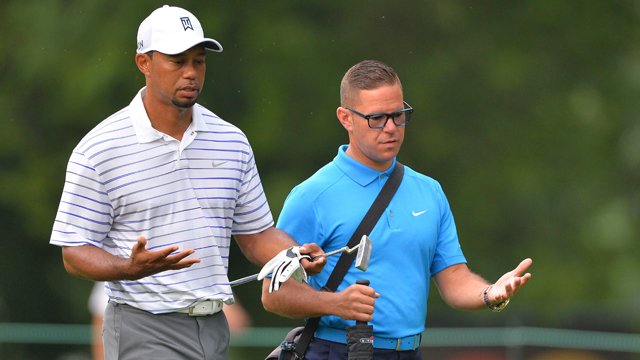On Monday, Tiger Woods announced on his website that he and his instructor Sean Foley had parted ways, ending a teaching relationship that began after the 2010 PGA Championship. Previously, Tiger had stints with Butch Harmon (1993-2003) and Hank Haney (2004-2010). Although Tiger had a very successful 2013 season, winning five times including The Players Championship, he failed to gain ground on his holy grail quest of Jack Nicklaus’s career record of 18 major championships. And along the way, he has suffered physical setbacks on his back and knee.
The split up announcement pleased critics of Foley who claimed his work with Tiger was not up to snuff. The Golf Channel’s Brandel Chamblee had been particularly vocal in his criticism of Foley’s teaching methods. In a July 29 telecast, he said, “Watching a guy swing that short and that quick and develop the yips—and there is no other word for it, the yips—with his driver is really sad to see.” Chamblee then added, “he is never, ever going to dominate with this move unless he changes it…”
From a layman’s perspective, it seemed to me that Tiger tended to dip his head and didn’t stay tall when driving. His transition from the backswing to the forward swing was also too abrupt. At other times, he lacked a consistent tempo which resulted in some big misses with his tee-ball which can’t be tolerated. Statistically, Tiger’s driving accuracy was rated at 55.10% this year, admittedly a shorter season due to his injuries. In 2013, it was 62.50% and ranked 69th on Tour. In 2012, he was ranked 53rd. In 2011, his first full season with Foley, his driving accuracy was 48.90%. So there was improvement at first but then a fall-off.
Looking back over the last ten years, Tiger’s was a fickle driver even under Hank Haney. But his misses were better and also mitigated by a rock-solid short game. It’s the decline in his short game prowess that drew my attention. In the PGA Tour’s scrambling stat from 30 yards in, Tiger managed to get up and down 26% of the time this past year. In 2013, it was around 26.5%. In contrast, short game master (although with occasional putting lapses) Phil Mickelson averaged 34%-35% over the last few years in the 30-yard scrambling stat. From 30 yards in, the best (Heath Slocum) averaged 51%. And the overall scrambling leader this year is Jim Furyk, making par or better 71% of the time despite missing the green.
Years ago, I always considered Tiger and Phil to be the top two chippers in the game. They chipped at times almost as good as they putted the ball. But over the last few years, Tiger’s chipping has fallen off. And for this I must fault Foley because his teaching method called for Tiger to change his once formidable chipping style. This is what I wrote after the 2011 Masters, Tiger’s first major under Foley’s tutelage, when he revealed how his short game had been adjusted under his new teacher:
“…Tiger’s putting and chipping over the last few years were never the problem. It was mainly a balky driver. So why he would mess with his once impregnable putting and chipping technique baffles me especially after seeing him miss short critical putts as he did on Sunday at 12 and 15 and with a mediocre chip on 13 which led to a costly par. For the week, Tiger tied with Justin Rose for the most three-putts with six. He also ended his Saturday round with a bogey set up by another poor chip from the back of the green. In his Tuesday press conference, Woods said his game is still undergoing a “process” where “the putting stroke, the short game, the swing, the same release has to mirror throughout the entire bag.” Sorry, I don’t get it.” (April 2011)
I have no idea who’ll be Tiger’s next swing guru but I’ll be very curious if Tiger returns to his once lofty short game method which provided so much support and strength to his long game.
Photo courtesy of the PGA of America

